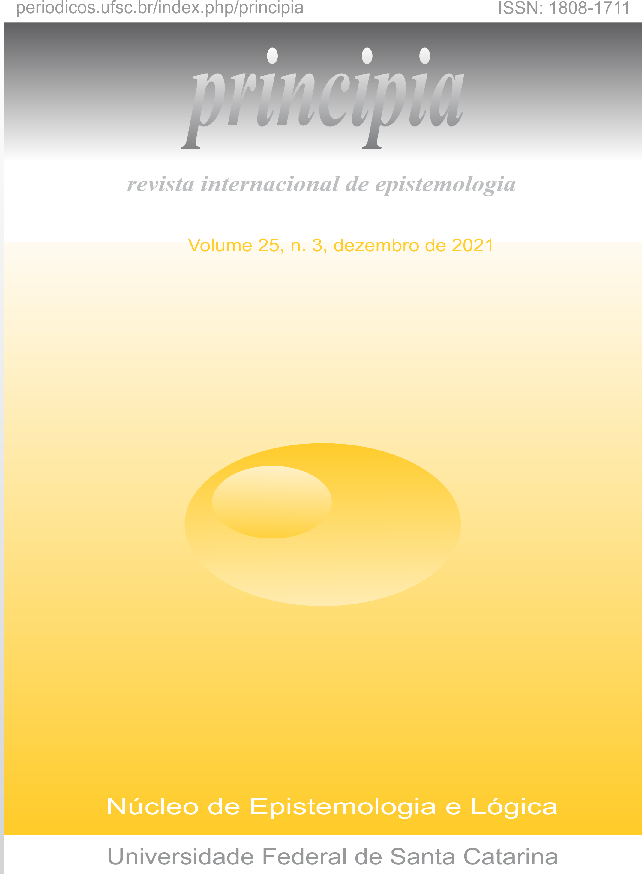Causalidade na Filosofia da Medicina e da Epidemiologia
DOI:
https://doi.org/10.5007/1808-1711.2021.e74077Resumo
A análise epistemológica das práticas das ciências da saúde vem se tornando mais presente no debate filosófico nas últimas décadas, e se torna premente diante do contexto dramático da pandemia em que atualmente vivemos. Para contribuir com a essa análise, o presente artigo apresenta uma introdução às temáticas da filosofia da medicina e da filosofia da epidemiologia, especialmente o exame do papel da causalidade, conceito fundamental para a compreensão da relação entre saúde e doença. A noção de causa INUS, formulada pelo filósofo J. L. Mackie e adaptada para a epidemiologia por Kenneth Rothman, permite retratar com precisão as interações multicausais que cooperam para a alteração de um estado de saúde. Contudo, o modelo visual de Rothman não contempla conceitos importantes da epidemiologia, imprecisão que busco sanar com uma proposta de representação temporal do conjunto multicausal que, dentre outras coisas, facilita o planejamento de intervenções pontuais que visem a impedir a instalação de uma doença. A delimitação do conjunto causal também é posta em questão, uma vez que a perspectiva multicausal não delimita intrinsecamente qualquer critério acerca de onde finalizar a seleção de fatores causais. Aponto para a manipulabilidade como a abordagem própria das ciências da saúde para a seleção dos fatores nos quais intervir, e que o reconhecimento dessa perspectiva é importante para a própria compreensão filosófica da causalidade.
Referências
Almeida Filho, N. 1992. Epidemiología sin números. Organización Panamericana de la Salud. Washington: Serie Paltex
Almeida Filho, N. & Rouquayrol, M. 2008. Introducción a la epidemiologia. Buenos Aires: Editora Lugar.
Arruda, R. 2021. Multicausalidade e Manipulação na Medicina. In: Perspectivas sobre o método científico. Seropédica: Editora do PPGFIL/UFRRJ. https://www.editorappgfilufrrj.org/pdfs/
perspectivas_metodo_cientifico.pdf. Acesso: 26/11/2021.
Bonita, R.; Beaglehole, R. & Kjellström T. 2010. Epidemiologia básica. Organização Mundial da Saúde. São Paulo: Santos. http://apps.who.int/iris/bitstream/10665/43541/5/9788572888394_por.pdf. Acesso: 21/08/2021.
Cartwright, N. 2007. Hunting Causes and Using Them: Approaches in Philosophy and Economics. Cambridge: Cambridge UP.
CDC/Centers for Disease, Control and Prevention. 2016. About HIV/AIDS. Atlanta: U.S. Department of Health & Human Services. https://www.cdc.gov/hiv/basics/whatishiv.html . Acesso: 21/08/2021.
Chisholm, R. 1946. The Contrary-to-Fact Conditional. Mind, New Series, 55(220): p. 289-307.
Criado, P., Criado, R., Maruta, Celina W. et al. 2005. Urticaria. An Bras Dermatol. 80(6): 613-32.
Evans, A. 1978. Causation and disease: a chronological journey. The Thomas Parran Lecture. American journal of epidemiology. 108(4): 249-58.
Gaetano, P. 2018. The British Doctors’ Study (1951–2001). Embryo Project Encyclopedia
Garg, S., Kim L., Whitaker, M. et al. 2020. Hospitalization Rates and Characteristics of Patients Hospitalized with Laboratory-Confirmed Coronavirus Disease 2019 — COVID-NET, 14 States, March 1–30, 2020. US Department of Health and Human Services/Centers for Disease Control and Prevention 69(15): 458-464.
Goodman, N. 1947. The Problem of Counterfactual Conditionals. The Journal of Philosophy, 44(5): p. 113-128.
Hempel, C. 1974. Filosofia da ciência natural. Rio de Janeiro: Zahar Editores.
Hill, A B. 1965. The environment and Disease: Association or Causation? Proceedings of the Royal Society of Medicine. 58(5): 295-300.
Holland, P. 1986. Statistics and Causal Inference. Journal of the American Statistical Association. 81(396): 945-960.
Lewis, D. 1973. Causation. The Journal of Philosophy, Seventieth Annual Meeting of the American Philosophical Association Eastern Division, 70(17): p. 556-567.
Mackie, J. L. 1965. Causes and Conditions. American Philosophical Quarterly 2(4): 245-264.
Mackie, J. L. 1980. The Cement of the Universe. Oxford: Clarendon Press.
Mill, J. S. 1882. A system of logic. Eighth Edition. New York: Harper & Brothers, Publishers.
Rothman, K. 1976. Causes. American Journal of Epidemiology 104(6): 587-92.
Rothman. K. 1981. Induction and latent periods. American Journal of Epidemiology 114(2): 253-259.
Rothman, K. & Greenland, S. 2005. Causation and Causal Inference in Epidemiology. American Journal of Public Health 95(S1): S144-S150.
Rothman, K., Greenland, S., Lash, T. et al. 2008. Causation and causal inference. Modern Epidemiology 3º edition. Philadelphia: Wolters Kluwer Health/Lippincott Williams & Wilkins.
Scriven, M. 1964. The Structure of Science. The Review of Metaphysics 17(3): 403-424.
Siebenhaar F., Weller, K., Mlynek A., Magerl, M. et al. 2007. Acquired cold urticaria: clinical picture and update on diagnosis and treatment. Clinical and Experimental Dermatology 32: 241-245.
Simon, V. 2005. Wanted: Women in Clinical Trials. Science 308(5728): 1517.
Tan, L., Wang, Q., Zhang, D. et al. 2020. Lymphopenia predicts disease severity of COVID-19: a descriptive and predictive study. Signal Transduction and Targeted Therapy 5(33): 1-3.
Wang, X., Xu, W., Hu, G. et al. 2020. SARS-CoV-2 infects T lymphocytes through its spike protein-mediated membrane fusion. Cell Mol Immunol. Letter: 1-3.
Woodward, J. 2003. Making Things Happen: A Theory of Causal Explanation. Oxford University Press. Oxford.
Woodward, J. 2013. Causation and Manipulability. The Stanford Encyclopedia of Philosophy (Winter Edition), Edward N. Zalta (ed.).
World Health Organization. 2015. Guideline on when to start antiretroviral therapy and on pre-exposure prophylaxis for HIV. WHO Library Cataloguing-in-Publication Data. Switzerland. https://apps.who.int/iris/bitstream/handle/10665/186275/9789241509565_eng.pdf. Acesso: 21/08/2021.
Downloads
Publicado
Edição
Seção
Licença
Copyright (c) 2021 Renata Arruda

Este trabalho está licenciado sob uma licença Creative Commons Attribution-NonCommercial-NoDerivatives 4.0 International License.

A obra Principia de http://www.periodicos.ufsc.br/index.php/principia/index foi licenciada com uma Licença Creative Commons Atribuição-NãoComercial-SemDerivações 4.0 Internacional.
Com base na obra disponível em www.periodicos.ufsc.br.



